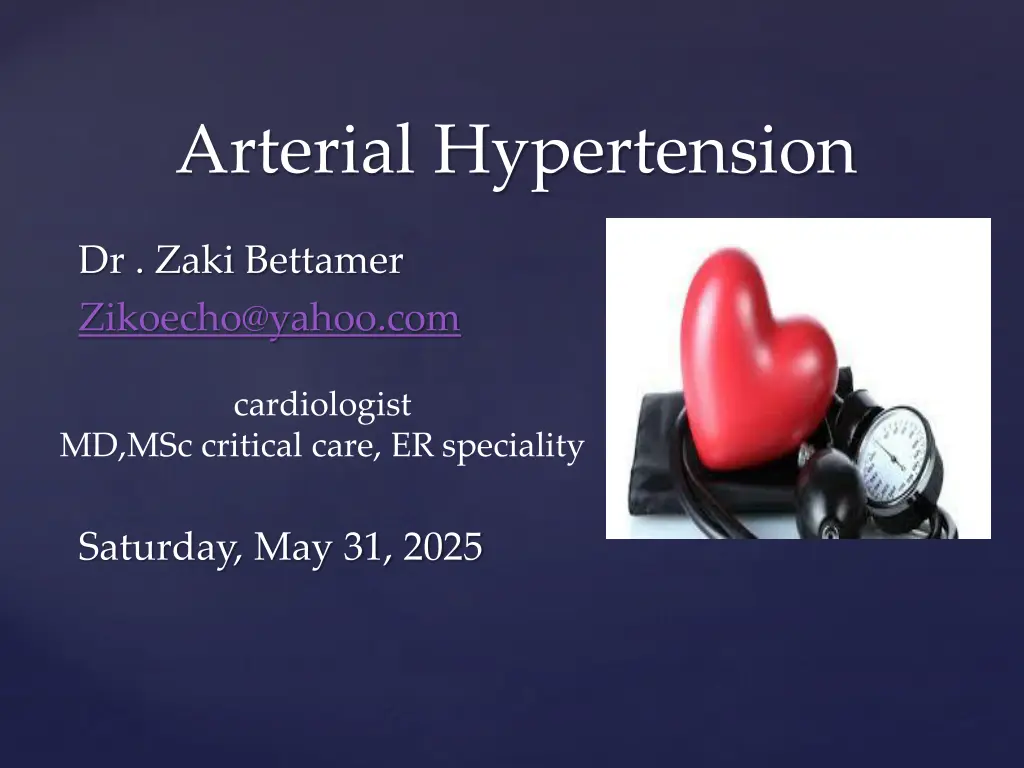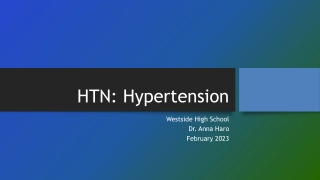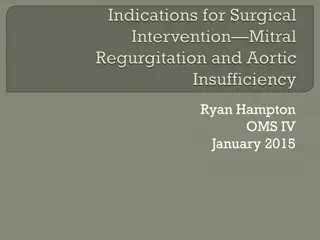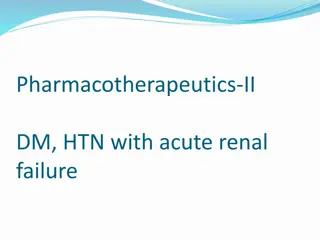
Understanding Arterial Hypertension in Adults
Learn about arterial hypertension in adults, its definition, classification, etiology, and pathogenesis. Explore the best starting medication for a 60-year-old male with hypertension symptoms. Understand the importance of diagnosing and treating hypertension for overall health and wellbeing.
Download Presentation

Please find below an Image/Link to download the presentation.
The content on the website is provided AS IS for your information and personal use only. It may not be sold, licensed, or shared on other websites without obtaining consent from the author. If you encounter any issues during the download, it is possible that the publisher has removed the file from their server.
You are allowed to download the files provided on this website for personal or commercial use, subject to the condition that they are used lawfully. All files are the property of their respective owners.
The content on the website is provided AS IS for your information and personal use only. It may not be sold, licensed, or shared on other websites without obtaining consent from the author.
E N D
Presentation Transcript
Arterial Hypertension Dr . Zaki Bettamer Zikoecho@yahoo.com cardiologist MD,MSc critical care, ER speciality Saturday, May 31, 2025
60 years old black male frequently suffering from headache and blurring vision with history of high BP reading, his mother is hypertensive. On examination : BP 175 / 110 , pulse 80 beat / minute regular, fundal examination show grade II hypertensive retinopathy otherwise normal, Echo and RFT are normal. the best starting medication of this patient is :
Definition Hypertension, or high blood pressure (BP), is defined as a persistent systolic blood pressure (SBP) > 140 mm Hg, diastolic blood pressure (DBP) > 90 mm Hg.
White coat hypertension: rise of B.P when measured in the clinic, but normal readings at home or with ambulatory B.P recordings. Hypertension is generally an asymptomatic condition. Individuals who remain undiagnosed and untreated for hypertension present the greatest challenge and opportunity for health care providers
Classification of hypertension Prehypertension: BP 120 to 139 / 80 to 89 mm Hg Stage 1(mild): BP 140 to 159 / 90 to 99 mm Hg Stage 2 (Moderate):SBP >160 or DBP >100 mm Hg. Stage 3 ( severe): SBP >180 or DBP>110.
ETIOLOGY OF HYPERTENSION Primary (essential or idiopathic) hypertension: elevated BP without an identified cause; accounts for 90% to 95% of all cases of hypertension. Secondary hypertension: elevated BP with a specific cause; accounts for 5% to 10% of hypertension in adults.
Pathogenesis of primary HTN Insulin Resistance Obesity RAS Cardiac Output Na Intake Genetics Peripheral Resistance Na Excretion CM Alterations Endothelial Stress dysfunction
Theories of primary hypertension: 1. Renal Theory: There is increase of renin secretion. 2. Increased adrenal gland activity Aldosterone secretion. 3. Increased activity of VMC sympathetic discharge Blood pressure. 4. Multifactorial theory: + VMC Vasospasm (sympathetic) Renal ischaemia Stress renin increase return to normal blood pressure by time Persistent hypertension. VMC : VasoMotor Center
5. Barroreceptors resetting. 6. Impaired pressure natriuresis. 7. COP - P.R. 8. Genetic factors, hypertension tends to run in families and children of hypertensive parents. 9. Insulin resistance, obesity. IO.Alcohol intake, excessive sodium intake or salt sensitivity.
Causes of secondary hypertension Renal disease: Renal artery stenosis. Glomerulonephritis polycystic kidney disease. Endocrine: Phaeochromocytoma. Cushing s syndrome, acromegaly, primary hypothyroidism, thyrotoxicosis. Drugs: O.C.P, steroids, NSAIDs, sympathomimetic drugs. Coarctation of aorta. Pregnancy.
CLINICAL MANIFESTATIONS OF HYPERTENSION Often called the silent killer because it is frequently asymptomatic until it becomes severe and target organ disease occurs. Rarely can present with headache or encephalopathy.
Target organ damage The heart: Atrial fibrillation. Left ventricular hypertrophy and failure. Coronary artery disease. The blood vessels: Atherosclerosis. Aortic aneurysm. Aortic dissection.
Target organ damage The brain: Stroke. Subarachnoid hemorrhage. Hypertensive encephalopathy. The kidneys: Protenuria. Renal failure.
Target organ damage Retina: Grade 1:arteriolar thickening (silver wiring). Grade 2: grade 1 plus constriction of veins at arterial crossing (A.V. nipping). Grade 3: grade 2 plus retinal hemorrhage (flame shaped) & cotton wool exudate. Grade 4: grade 3 plus papilloedema.
Malignant hypertension Accelerated microvascular damage with necrosis in small arteries walls (fibrinoid necrosis) & intravascular thrombosis. High B.P with rapidly progressive end organ damage ( Grade retinopathy, renal failure, or encephalopathy ).
History Family history of HTN. Risk factors of CAD: DM, hyperlipidemia, smoking. Symptoms of secondary HTN. Complications of HTN: CAD, CVA,PVD.
Examination Radiofemoral delay: coarctation of aorta. Enlarged kidneys: polycystic kidneys. Abdominal bruits: renal artery stenosis. Central obesity. Heart: S4, accentuation of aortic component of S2.
Investigations of hypertension All patients should have: Urinalysis for blood, protein, glucose. Renal function test. Blood glucose. Serum lipids. ECG.
Optimal target B.P. control Non diabetic: <140/85 Diabetic: <130/80
Hypertension: investigation of selected patients Chest X-ray: to detect cardiomegaly, heart failure, coarctation of the aorta Ambulatory BP recording: to assess borderline or white coat hypertension Echocardiogram: to detect or quantify left ventricular hypertrophy Renal ultrasound: to detect possible renal disease Renal angiography: to detect or confirm presence of renal artery stenosis Urinary catecholamines: to detect possible phaeochromocytoma Urinary cortisol and dexamethasone suppression test: to detect possible Cushing s syndrome Plasma renin activity and aldosterone: to detect possible primary aldosteronism
Approach to newly diagnosed HTN To obtain accurate measurement of B.P. To identify underlying cause. To assess other risk factors & quantify C.V. risk. To detect complications (target organ damage). To identify comorbidity that influence the choice of antihypertensive drug.
Non pharmacological treatment Risk factors modification: Stop smoking. Treat hyperlipidemia and diabetes. Weight reduction. Low salt diet.
Pharmacological treatment A: Angiotensin converting enzyme inhibitors (ACEI),Angiotensin receptor blockers. B: beta blockers. C: Calcium channel blockers. D: Diuretics. Others:Alpha blockers, centrally acting drugs (methyldopa, clonidine).
ACE inhibitors. ACE inhibitors (e.g. enalapril 20 mg daily, ramipril 5 10 mg daily or lisinopril 10 40 mg daily) inhibit the conversion of angiotensin I to angio-tensin II and are usually well tolerated. They should be used with particular care in patients with impaired renal function or renal artery stenosis because they can reduce the filtration pressure in the glomeruli and precipitate renal failure. Electrolytes and creatinine should be checked before and 1 2 weeks after commencing therapy. Side-effects include first-dose hypotension, cough, rash, hyperkalaemia and renal dysfunction.
Angiotensin receptor blockers Angiotensin receptor blockers (e.g. irbesartan 150 300 mg daily, valsartan 40 160 mg daily) block the angiotensin II type I receptor have similar effects to ACE inhibitors however, they do not cause cough and are better tolerated.
Beta-blockers. These are no longer used as first line antihypertensive therapy, except in patients with another indication for the drug (e.g. angina). Metoprolol (100 200 mg daily), atenolol (50 100 mg daily) and bisoprolol (5 10 mg daily). preferentially block cardiac 1 adrenoceptors, as opposed to the 2 - adrenoceptors that mediate vasodilatation and bronchodilatation. Labetalol and carvedilol. Labetalol (200 mg 2.4 g daily in divided doses) and carvedilol (6.25 25 mg twice daily) are combined - and - adrenoceptor antagonists which are sometimes more effective than pure -blockers. Labetalol can be used as an infusion in malignant phasenhypertension .
Calcium channel antagonists. The dihydropyridines (e.g. amlodipine 5 10 mg daily, nifedipine 30 90 mg daily) are effective and usually well- tolerated antihypertensive drugs that are particularly useful in older people. Side-effects include flushing, palpitations and fluid retention. The rate limiting calcium channel antagonists (e.g. diltiazem 200 300 mg daily, verapamil 240 mg daily) can be useful when hypertension coexists with angina but they may cause bradycardia. The main sideeffect of verapamil is constipation.
Other drugs A variety of vasodilators may be used. These include the 1 -adrenoceptor antagonists ( -blockers), such as prazosin (0.5 20 mg daily in divided doses), indoramin (25 100 mg twice daily) and doxazosin (1 16 mg daily). drugs that act directly on vascular smooth muscle, such as hydralazine (25 100 mg twice daily) and minoxidil (10 50 mg daily). Side-effects include first dose and postural hypotension, headache, tachycardia and fluid retention. Minoxidil also causes increased facial hair and is therefore unsuitable for female patients.
Thiazide and other diuretics The mechanism of action of these drugs is incompletely understood and it maytake up to a month for the maximum effect to be observed. daily dose is 2.5 mg bendroflumethiazide or 0.5 mg cyclopenthiazide. More potent loop diuretics, such as furosemide (40 mg daily) or bumetanide (1 mg daily), have few advantages over thiazides in the treatment of hypertension, unless there is substantial renal impairment or they are used in conjunction with an ACE inhibitor.
Aged > 55 yrs or black person of any age Aged < 55 yrs Step 1 A C Step 2 A + C Step 3 A + C + D Resistant hypertension A + C + D + consider further diuretic or - or -blocker 5 Consider seeking expert advice Step 4
Choice of antihypertensive Old age: diuretic/ CCB. Pregnant: Methyldopa, beta blocker. Angina: beta blocker. Diabetic: ACEI
Hypertensive crises are classified as emergencies or urgencies , based on the presence or absence of progressive target organ dysfunction. Urgencies: severe BP without evidence of acute or progressive target organ dysfunction
If no acute organ damage, does not necessarily require hospital admission. Rest the patient in a quite room. Repeat BP after 1 2 h to confirm. If DBP still > 130mmHg treat. Use the same oral agents as in emergency. Start with a single agent.
Aim for diastolic BP 100 110mmHg at first. Recheck BP after 24 48h. If still uncontrolled, increase dose, or add in second agent. Recheck after every 2 3 days until BP at desired level. Treat according to guidelines.
Emergencies: severe BP complicated by evidence of acute or progressive target organ damage, such as Cardiac ischaemia (ACS) Encephalopathy Stroke Pulmonary oedema Renal failure.
Initial aim of treatment is to d DBP to 110 115mmHg. Aim to achieve this in 2 6 hours. Parenteral agents are often required Sodium nitroprusside, Labetalol , Glyceryl trinitrate Once BP within target range, transfer to oral agent, and wean IV infusion over 4 8h.
Regarding the investigation of patient with hypertension : Renal ultrasound is good indicator for primary hypertension. Ambulatory BP recording to assess white coat hypertension. Urinary catecholamines to detect possible Cushing s syndrome. Echocardiogram to detect mitral valve stenosis as cause of hypertension. Plasma renin activity and aldosterone to detect phaeochromocytoma. {
60 years old black male frequently suffering from headache and blurring vision with history of high BP reading, his mother is hypertensive. On examination : BP 175 / 110 , pulse 80 beat / minute regular, fundal examination show grade II hypertensive retinopathy otherwise normal, Echo and RFT are normal. the best starting medication of this patient is : Calcium Chanel Blockers ( CCB ) B - Blockers Alpha 1 Blockers Angiotensin Receptor Blockers ( ARBs ) Methyldopa {




